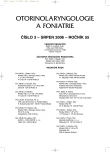-
Medical journals
- Career
Standard and Puncture Dilatation Tracheostomy: Comparison of Results and Complications
Authors: J. Lukáš 1; J. Valvoda 1,2; P. Rambousek 1; prof. MUDr. Jan Bělohlávek, Ph.D. 2; F. Novák 3; Stříteský M. Dušková J. 4 5; T. Haas 6
Authors‘ workplace: ORL oddělení VFN Praha ; přednosta doc. MUDr. M. Hroboň, CSc. II. interní klinika 1. LF UK a VFN, Praha 1; přednosta prof. MUDr. M. Aschermann, DrSc. IV. interní klinika 1. LF UK a VFN Praha 2; přednosta doc. MUDr. A. Žák, CSc. Klinika anesteziologie a resuscitace 1. LF UK a VFN, Praha 3; přednosta M. Stříteský, CSc. Ústav patologie 1. LF UK a VFN, Praha 4; přednosta prof. MUDr. C. Povýšil, DrSc. Ústav biofyziky 1. LF UK a VFN, Praha 5; přednosta doc. Ing. M. Špunda, CSc. 6
Published in: Otorinolaryngol Foniatr, 55, 2006, No. 3, pp. 144-149.
Category: Original Article
Overview
To perform analysis of results based on a prospective randomized study and to compare the occurrence of perioperative and postoperative complications in puncture dilatation and standard surgical tracheostomy.
In the period of January 2003 to December 2005, 205 trachemostomies (100 PDT and 105 ST) by endotracheal intubation were performed in critically ill patients at the Intensive Care Units of general Teaching Hospital in Prague. The indication for elective tracheostomy was to secure respiratory pathways in longterm artificial lung ventilation. The study included patients who fulfilled entry and output criteria of the study protocol and were selected for performing PDT or ST by an envelope method. The interventions were performed in analgesic sedation and relaxation, ST was made by a modified stem lobe according to Björk, PDT by the dilatation method according to Griggs using pean forceps (clamp).
In both techniques there was a similar indication for the intervention, as well as age, sex of the patients, and duration of endotracheal intubation. No statistically significant difference was found in the number of decannulated patients (altogether 46%) or in the time period required for decannulation (average time period was 30.3 days in PDTY and 32.2 days in ST), or in the number of deceased patients with tracheostomy (43% altogether) with PDT, which concerned 40 patients with PDT and 47 patients with ST. A statistically significant difference of the time to perform tracheostomy (p < 0.001) was found between PDT (5.5 min) and ST (15.1 min) as well as the number of temporary carriers of tracheostomic cannula (p=0.0131) with PDT (15 patients) and ST (5 patients). The incidence of early postoperative complications was 9% in PDT against 0.9% in ST. The incidence of early postoperative complications was 22% in PDT against 8.6% in ST. Bleeding was the most frequent postoperative complication, which was encountered 17 times in PDT and 4 times in ST. The incidence of late complications was 2% in PDT and 6.6% in ST. Post mortem examination of tracheostomy was performed in 26 deceased patients (8 in PDT and 128 in ST).
There was not any statistically significant difference in the localization of tracheostomy on trachea or in the occurrence of microscopic changes on mucosa.
Our study established the predominance of perioperative and early postoperative complications in PDT. In contrast, late complications occurred more frequently with ST.Key words:
standard surgical tracheostomy, pucture dilatation analysis of complications.
Labels
Audiology Paediatric ENT ENT (Otorhinolaryngology)
Article was published inOtorhinolaryngology and Phoniatrics

2006 Issue 3-
All articles in this issue
- Is it Important to Evaluate the Size of Adenoid Vegetations?
- A Comparison of Analgesic Efficiency in Patients after Tonsillectomy
- Standard and Puncture Dilatation Tracheostomy: Comparison of Results and Complications
- Biopsy of Sentinel Nodes in Head and Neck Carcinomas
- Narrowing of Pharynx and Trachea in Children
- Surgical Therapy of Malignant Tumors of Thyroid Gland in Children
- Functional Aspects in Morphology of Nasal Mucosa
- Otorhinolaryngology and Phoniatrics
- Journal archive
- Current issue
- Online only
- About the journal
Most read in this issue- Narrowing of Pharynx and Trachea in Children
- Standard and Puncture Dilatation Tracheostomy: Comparison of Results and Complications
- Is it Important to Evaluate the Size of Adenoid Vegetations?
- A Comparison of Analgesic Efficiency in Patients after Tonsillectomy
Login#ADS_BOTTOM_SCRIPTS#Forgotten passwordEnter the email address that you registered with. We will send you instructions on how to set a new password.
- Career

